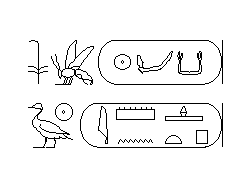
Der zweite König der 18. Dynastie, der Sohn von Ahmose I. und Ahmose-Nofretere. Man vermutet, daß er sehr jung war, als er den Thron bestieg und daß seine Mutter wahrscheinlich einige Zeit die Regentschaft führte. Amenophis führte die Politik seines Vorgängers fort. Er wollte den Frieden in Ägypten wiederherstellen und arbeitete an seinem Wiederaufbau. Außerdem drang er weiter nach Nubien vor als Ahmose und eroberte das Land, das so zu Ägyptens wichtigster Goldquelle wurde. Während seiner Regierungszeit wurde der berühmte medizinische Papyrus Ebers geschrieben. Dieser enthält ein genaues Sothisdatum, eine wichtige Hilfe bei der Erstellung einer absoluten Chronologie. Amenophis I. und seiner Mutter wird die Gründung des Arbeiterdorfes Deir el-Medina zugeschrieben. Dies ist wahrscheinlich der Grund, warum er bald nach seinem Tod eine Schutzgottheit der thebanischen Nekropole und insbesondere von Deir el-Medina wurde. Zusammen mit seiner Mutter Ahmose-Nofretere hatte er einen Totentempel auf dem Westufer von Theben. Amenophis wurde besonders von den Arbeitern in Deir el-Medina verehrt. Stelen und Texte auf Ostraka und Papyri weisen darauf hin, daß eine Statue des Königs bei Prozessionen als Orakel befragt wurde. Einmal jährlich wurde ein großes viertägiges Fest für Amenophis im Monat Pamenoth gefeiert, der den Namen des Königs trug (Pamenoth heißt 'der (Monat) des Amenophis').